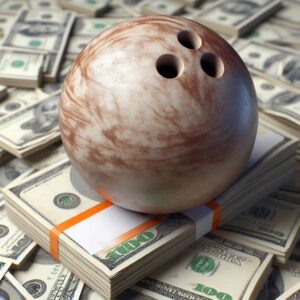Keeping your bowling ball in pristine condition is crucial for both the performance and longevity of your equipment. Over time, your ball can accumulate dirt, oil, and residue from repeated use on the lanes.
This buildup can negatively impact the ball’s hook, traction, and overall responsiveness. That’s why it’s so important to regularly clean your bowling ball – and one of the most effective methods is using rubbing alcohol.
In this comprehensive guide, we’ll walk you through the step-by-step process of cleaning your bowling ball with rubbing alcohol. We’ll cover everything from the necessary supplies to the proper techniques, as well as provide tips for maintaining your ball’s cleanliness in between deep cleanings. By the end, you’ll have all the knowledge you need to keep your bowling ball performing at its best.
Gather the Necessary Supplies
The first step in cleaning your bowling ball with rubbing alcohol is to make sure you have all the necessary supplies on hand. Here’s what you’ll need:
- Isopropyl Alcohol (70-91% Concentration) – The key ingredient in this cleaning method is isopropyl alcohol, also known as rubbing alcohol. You’ll want to use a concentration between 70-91% for optimal cleaning power. Avoid using lower concentrations, as they may not be as effective.
- Clean Cloth or Rag – You’ll need a clean, lint-free cloth or rag to apply the rubbing alcohol and wipe down the bowling ball. Avoid using paper towels, as they can leave behind fibers.
- Small Cleaning Brush (Optional) – For getting into the nooks and crannies of the finger holes and other hard-to-reach areas, a small cleaning brush can be helpful. An old toothbrush works great for this.
- Bucket or Container – You’ll need a container or bucket to hold the rubbing alcohol. This will make it easier to dip your cloth or brush into the solution.
Safety Precautions
Before we jump into the cleaning process, it’s important to note a few safety precautions when working with rubbing alcohol:
- Ensure the area is well-ventilated, as the fumes can be strong.
- Wear gloves to protect your hands.
- Avoid getting the alcohol in your eyes or mouth.
- Keep the rubbing alcohol away from open flames or high heat sources.
- Dispose of any used cleaning supplies properly.
Now that you have your supplies ready, let’s dive into the step-by-step process for cleaning your bowling ball with rubbing alcohol.
Prepare the Bowling Ball for Cleaning
The first step in the cleaning process is to thoroughly inspect your bowling ball and remove any accessories or tape. This will ensure you can clean the entire surface of the ball effectively.
Start by checking the ball for any cracks, gouges, or other damage. If you notice any significant issues, it’s best to consult a professional pro shop before proceeding with the cleaning. Damaged balls may require more extensive repair or resurfacing.
Next, remove any tape, inserts, or other accessories that may be attached to the ball. This includes things like finger hole inserts, balance holes, or any other modifications. You want the ball’s surface to be as exposed as possible for the cleaning process.
Once the ball is prepped, you’re ready to begin the actual cleaning.
Step-by-Step Cleaning Process
- Pour a small amount of the 70-91% isopropyl alcohol into your bucket or container. You only need a small amount, as you don’t want to soak the ball.
- Dip your clean cloth or rag into the rubbing alcohol solution. Squeeze out any excess, so the cloth is damp but not dripping wet.
- Gently rub the damp cloth all over the surface of the bowling ball. Apply even pressure and cover the entire area, including the sides and back of the ball.
- Pay special attention to the finger holes and other hard-to-reach areas. Use a small cleaning brush (like an old toothbrush) to scrub these spots and ensure you remove all the built-up dirt and oil.
- Continue wiping down the ball until the cloth no longer picks up any visible residue or discoloration. You may need to re-dip the cloth in the alcohol solution a few times to maintain its cleaning power.
- Once you’ve thoroughly cleaned the entire surface of the ball, use a dry, lint-free cloth to wipe it down and remove any remaining moisture.
Allow the Ball to Fully Dry
After the cleaning process, it’s crucial to let your bowling ball fully air dry before using it again. Rubbing alcohol evaporates quickly, but you still want to give it ample time to ensure there’s no lingering moisture.
Depending on the temperature and humidity of your environment, this drying process can take anywhere from 30 minutes to an hour. You can speed things up by placing the ball in front of a fan or in a well-ventilated area.
Inspect the Ball for Any Remaining Residue
Once the ball is completely dry, do a final inspection to ensure you’ve removed all the built-up dirt, oil, and residue. Run your fingers over the surface and check the finger holes for any remaining grime.
If you notice any areas that still look a bit dull or dirty, repeat the cleaning process in those specific spots. You may need to scrub a little harder or apply the alcohol solution more liberally.
Applying a Light Coat of Bowling Ball Polish or Conditioner (Optional)
After the ball is thoroughly cleaned and dried, you can optionally apply a light coat of bowling ball polish or conditioner. This step is not strictly necessary, but it can help protect the ball’s surface and maintain its responsiveness.
Bowling ball polishes and conditioners typically contain lubricants and sealants that help rejuvenate the ball’s cover stock. They can restore some of the ball’s original sheen and help it glide more smoothly down the lane.
Follow the instructions on your chosen product, applying a thin, even layer over the entire surface of the ball. Avoid using too much, as this can actually have the opposite effect and make the ball too slick.
Maintaining Your Bowling Ball’s Cleanliness
Regularly cleaning your bowling ball with rubbing alcohol is an essential part of maintaining its performance and longevity. But how often should you do this deep cleaning process?
As a general rule of thumb, it’s recommended to clean your ball after every use on the lanes. This helps prevent the buildup of dirt, oil, and residue that can quickly accumulate over time.
If you bowl more frequently – for example, several times per week – you may want to consider cleaning your ball even more often, perhaps every 1-2 weeks. Bowlers who only hit the lanes occasionally (e.g., once a month) can probably get away with a monthly deep cleaning.
In between these deep cleanings with rubbing alcohol, you can also perform quick maintenance wipe-downs. Simply use a clean, dry cloth to quickly remove any surface-level dirt or oil that may have accumulated. This helps keep your ball performing at its best.
Additionally, be sure to store your bowling ball properly when not in use. Keep it in a cool, dry place, away from direct sunlight or extreme temperatures. Avoid leaving it in your car, as the fluctuating temps can be detrimental.
Signs That Your Bowling Ball Needs a Deeper Cleaning
Even if you’re maintaining a regular cleaning schedule, there may be times when your bowling ball needs a more thorough, deep cleaning with rubbing alcohol. Here are some signs to look out for:
- Your ball’s hook or responsiveness seems diminished
- The surface appears dull, cloudy, or discolored
- There’s visible built-up dirt, oil, or residue in the finger holes or on the coverstock
- The ball starts to develop an unpleasant odor
If you notice any of these issues, it’s a clear indication that your ball could benefit from a rubbing alcohol cleaning. Don’t hesitate to tackle this task – keeping your equipment in top condition is crucial for consistent performance on the lanes.
The Benefits of Regularly Cleaning Your Bowling Ball
Regularly cleaning your bowling ball with rubbing alcohol offers several key benefits:
- Improved ball reaction and performance The removal of built-up dirt, oil, and residue helps restore your ball’s original hook, traction, and responsiveness. This translates to more control and consistency on the lanes.
- Extended ball life By preventing excessive wear and tear, regular cleanings can help maximize the lifespan of your bowling ball. A well-maintained ball will retain its integrity and performance for much longer.
- Reduced risk of damage Letting grime and contaminants accumulate on your ball can potentially lead to cracks, warping, or other structural issues over time. Thorough cleanings help you avoid these problems.
- Improved hygiene and safety Regularly cleaning your ball minimizes the transfer of germs, bacteria, and other undesirable substances from the lanes to your hands. This helps maintain good hygiene and reduces the risk of skin irritation or illness.
- Enhanced consistency With your ball performing at its best, you’ll be able to achieve more consistent shots and scores on the lanes. This can give you a significant competitive advantage.
By implementing a regular cleaning routine with rubbing alcohol, you’re making a smart investment in the longevity and performance of your valuable bowling equipment. It’s a simple yet essential step that every serious bowler should take.
Conclusion
Keeping your bowling ball in pristine condition is crucial for both its performance and longevity. One of the most effective ways to clean your ball and restore its responsiveness is by using rubbing alcohol (isopropyl alcohol).
In this comprehensive guide, we’ve walked you through the step-by-step process of cleaning your bowling ball with rubbing alcohol. From gathering the necessary supplies to executing the cleaning technique and maintaining your ball’s cleanliness, you now have all the knowledge you need to keep your equipment performing at its best.
Remember to inspect your ball regularly, clean it after every use, and consider applying a light coat of bowling ball polish or conditioner as the finishing touch. By following these best practices, you can ensure your bowling ball continues to hook, grip, and perform exactly the way you need it to on the lanes.
So what are you waiting for? Grab your rubbing alcohol, gather your cleaning supplies, and get to work restoring your bowling ball to pristine condition. Your scores (and your equipment) will thank you.





